Urban Planning Process: Questions on Informal Economies Analysis
VerifiedAdded on 2023/06/11
|6
|1122
|397
Homework Assignment
AI Summary
This assignment delves into the intricacies of informal economies within the context of urban planning. It addresses key questions regarding the definition of informal economies, the three main approaches to their theorization (dualist, structuralist, and legalist), and the labor standards that should be promoted. The assignment further explores similarities between neo-Marxist and legalist perspectives, the relationship between drug economies and informal economies, and the impact of modernization and colonial spatial imaginaries on street vending. Examples of global cities with significant street vendor populations are provided, along with a discussion of indigenous activities within the informal economy. The document concludes by referencing scholarly articles, highlighting the complex challenges and considerations involved in understanding and managing informal economies in urban spaces. Desklib provides more solved assignments.
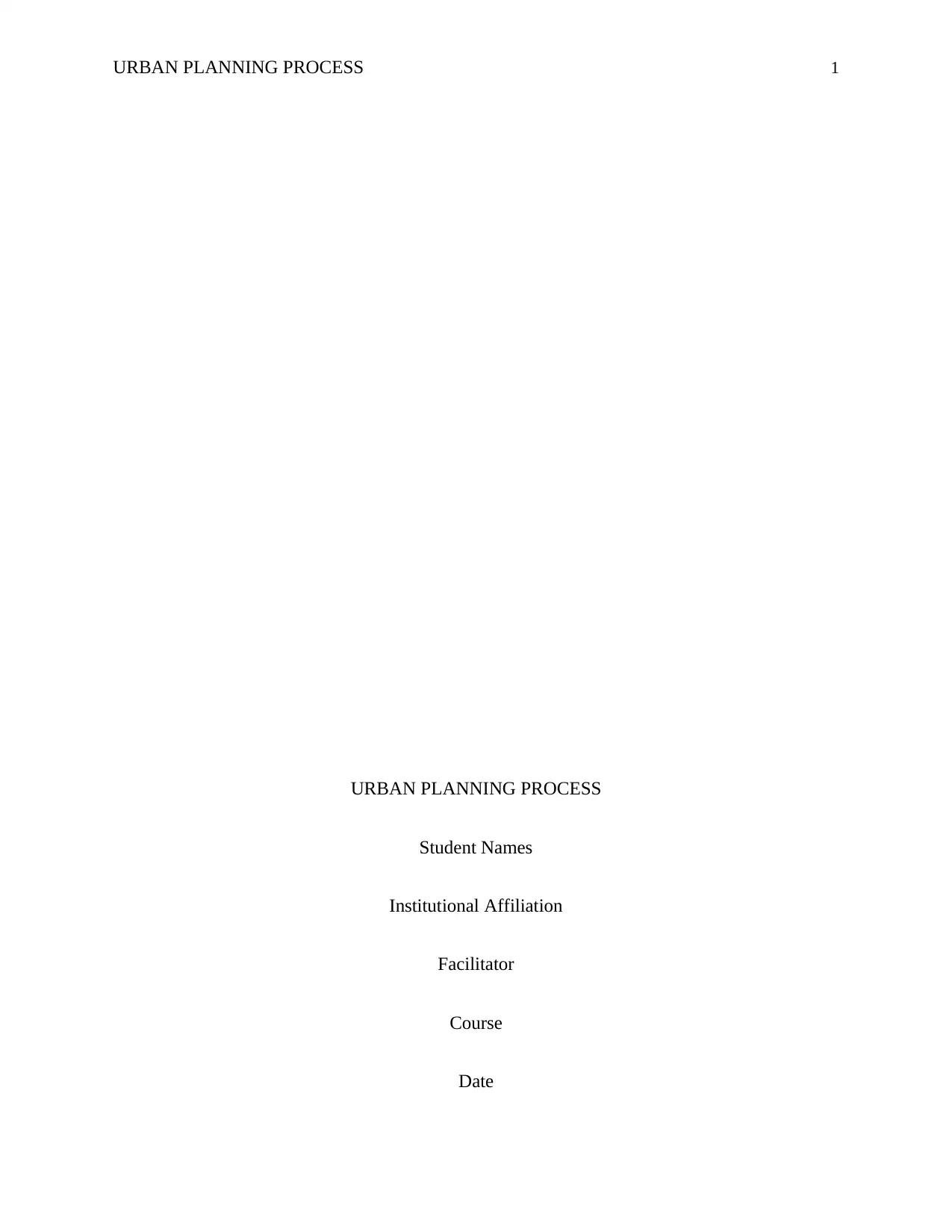
URBAN PLANNING PROCESS 1
URBAN PLANNING PROCESS
Student Names
Institutional Affiliation
Facilitator
Course
Date
URBAN PLANNING PROCESS
Student Names
Institutional Affiliation
Facilitator
Course
Date
Paraphrase This Document
Need a fresh take? Get an instant paraphrase of this document with our AI Paraphraser
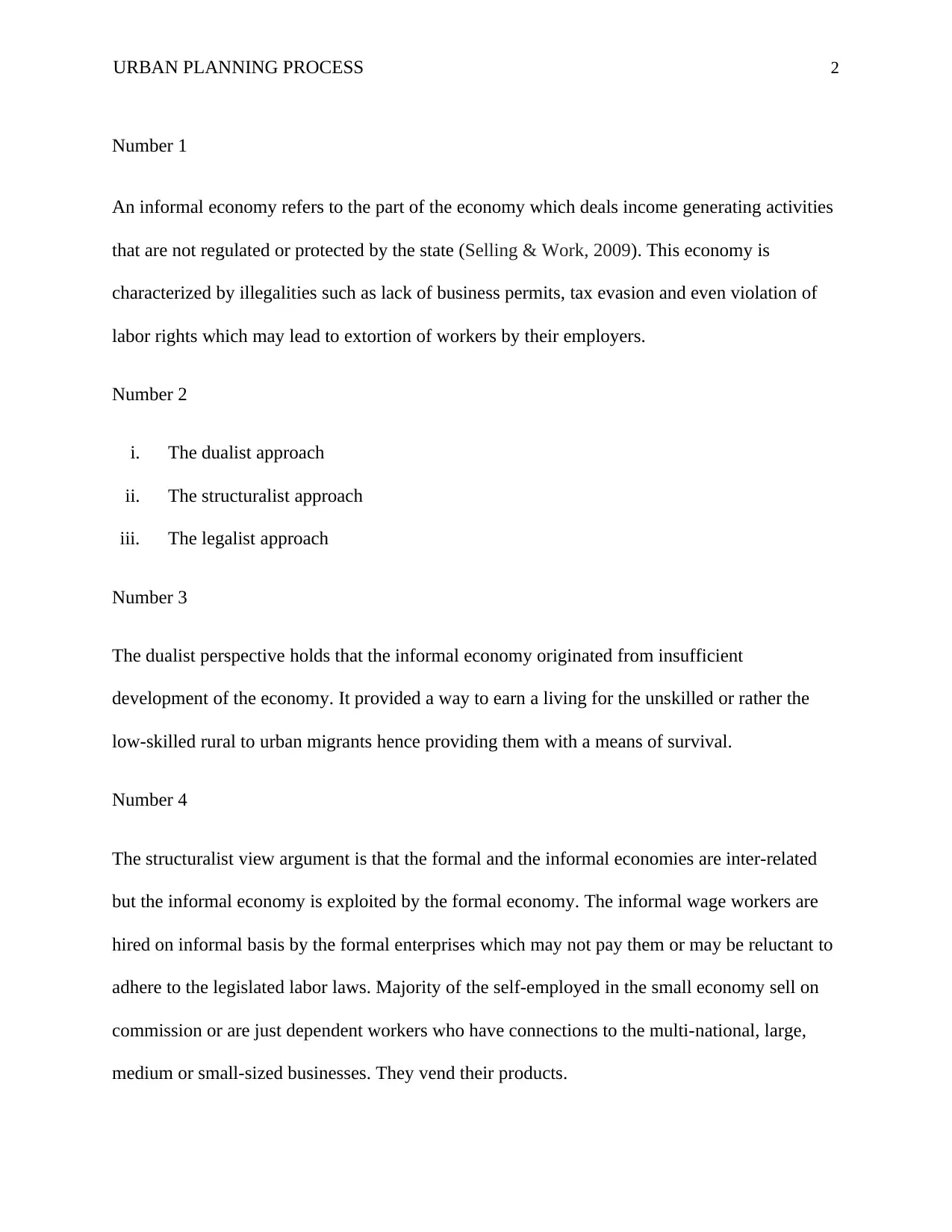
URBAN PLANNING PROCESS 2
Number 1
An informal economy refers to the part of the economy which deals income generating activities
that are not regulated or protected by the state (Selling & Work, 2009). This economy is
characterized by illegalities such as lack of business permits, tax evasion and even violation of
labor rights which may lead to extortion of workers by their employers.
Number 2
i. The dualist approach
ii. The structuralist approach
iii. The legalist approach
Number 3
The dualist perspective holds that the informal economy originated from insufficient
development of the economy. It provided a way to earn a living for the unskilled or rather the
low-skilled rural to urban migrants hence providing them with a means of survival.
Number 4
The structuralist view argument is that the formal and the informal economies are inter-related
but the informal economy is exploited by the formal economy. The informal wage workers are
hired on informal basis by the formal enterprises which may not pay them or may be reluctant to
adhere to the legislated labor laws. Majority of the self-employed in the small economy sell on
commission or are just dependent workers who have connections to the multi-national, large,
medium or small-sized businesses. They vend their products.
Number 1
An informal economy refers to the part of the economy which deals income generating activities
that are not regulated or protected by the state (Selling & Work, 2009). This economy is
characterized by illegalities such as lack of business permits, tax evasion and even violation of
labor rights which may lead to extortion of workers by their employers.
Number 2
i. The dualist approach
ii. The structuralist approach
iii. The legalist approach
Number 3
The dualist perspective holds that the informal economy originated from insufficient
development of the economy. It provided a way to earn a living for the unskilled or rather the
low-skilled rural to urban migrants hence providing them with a means of survival.
Number 4
The structuralist view argument is that the formal and the informal economies are inter-related
but the informal economy is exploited by the formal economy. The informal wage workers are
hired on informal basis by the formal enterprises which may not pay them or may be reluctant to
adhere to the legislated labor laws. Majority of the self-employed in the small economy sell on
commission or are just dependent workers who have connections to the multi-national, large,
medium or small-sized businesses. They vend their products.
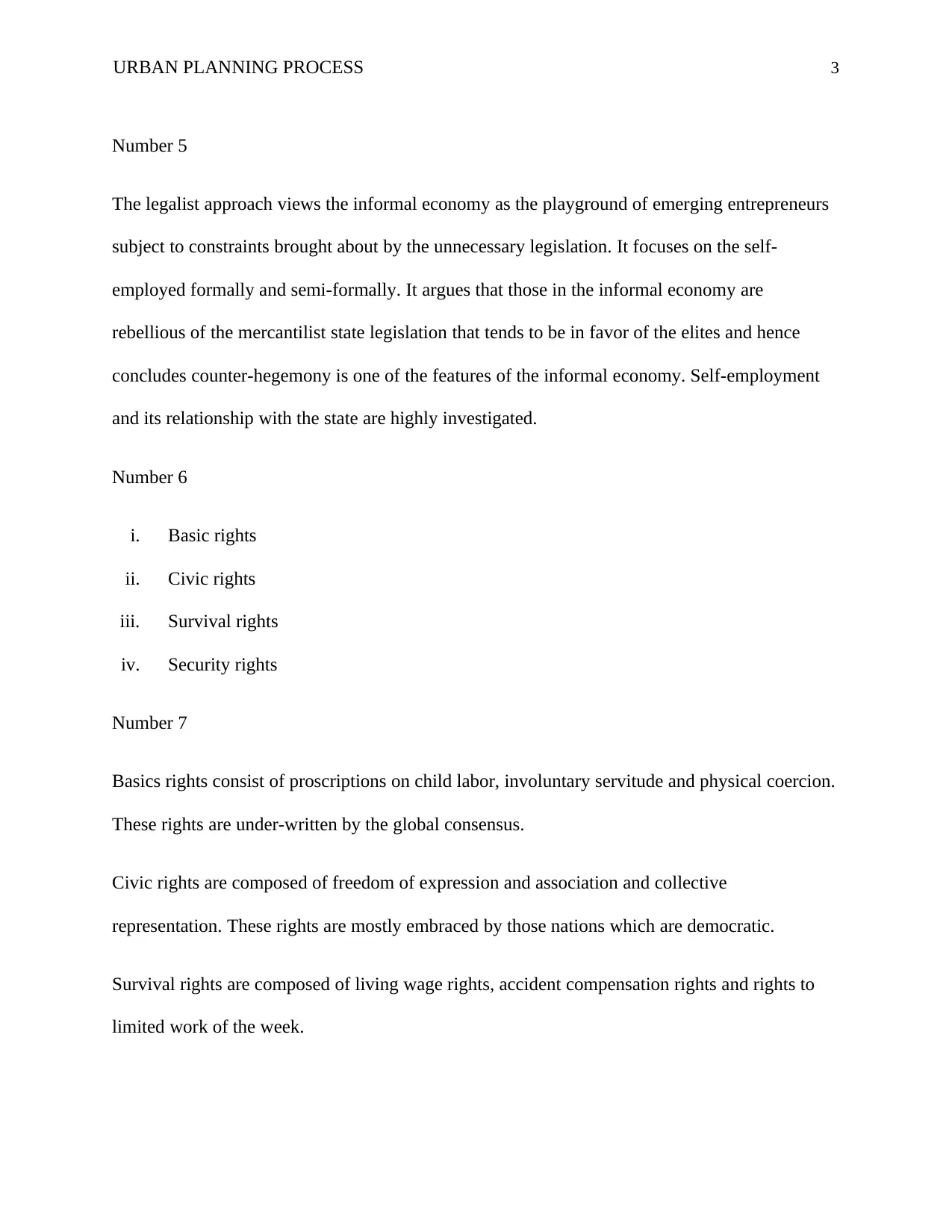
URBAN PLANNING PROCESS 3
Number 5
The legalist approach views the informal economy as the playground of emerging entrepreneurs
subject to constraints brought about by the unnecessary legislation. It focuses on the self-
employed formally and semi-formally. It argues that those in the informal economy are
rebellious of the mercantilist state legislation that tends to be in favor of the elites and hence
concludes counter-hegemony is one of the features of the informal economy. Self-employment
and its relationship with the state are highly investigated.
Number 6
i. Basic rights
ii. Civic rights
iii. Survival rights
iv. Security rights
Number 7
Basics rights consist of proscriptions on child labor, involuntary servitude and physical coercion.
These rights are under-written by the global consensus.
Civic rights are composed of freedom of expression and association and collective
representation. These rights are mostly embraced by those nations which are democratic.
Survival rights are composed of living wage rights, accident compensation rights and rights to
limited work of the week.
Number 5
The legalist approach views the informal economy as the playground of emerging entrepreneurs
subject to constraints brought about by the unnecessary legislation. It focuses on the self-
employed formally and semi-formally. It argues that those in the informal economy are
rebellious of the mercantilist state legislation that tends to be in favor of the elites and hence
concludes counter-hegemony is one of the features of the informal economy. Self-employment
and its relationship with the state are highly investigated.
Number 6
i. Basic rights
ii. Civic rights
iii. Survival rights
iv. Security rights
Number 7
Basics rights consist of proscriptions on child labor, involuntary servitude and physical coercion.
These rights are under-written by the global consensus.
Civic rights are composed of freedom of expression and association and collective
representation. These rights are mostly embraced by those nations which are democratic.
Survival rights are composed of living wage rights, accident compensation rights and rights to
limited work of the week.
⊘ This is a preview!⊘
Do you want full access?
Subscribe today to unlock all pages.

Trusted by 1+ million students worldwide
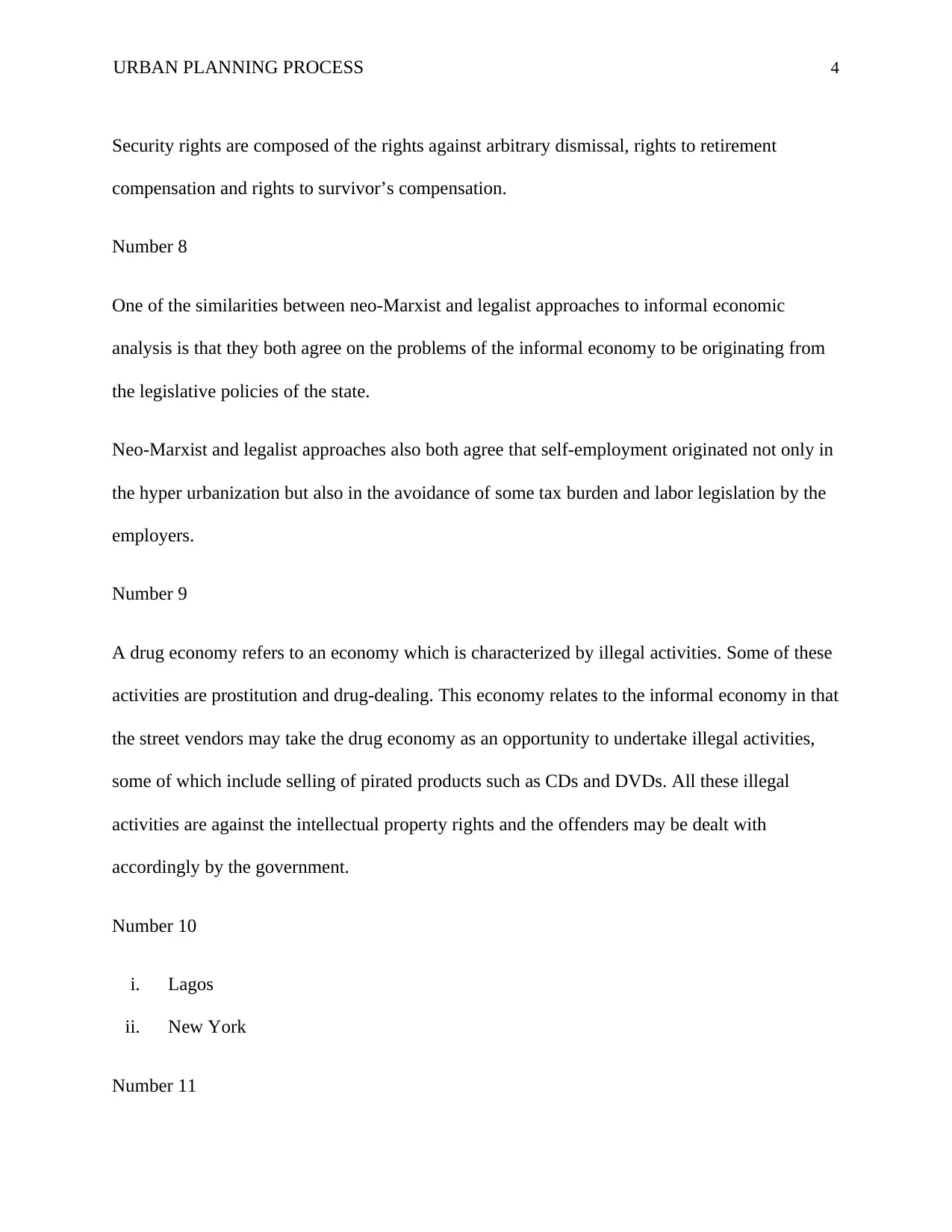
URBAN PLANNING PROCESS 4
Security rights are composed of the rights against arbitrary dismissal, rights to retirement
compensation and rights to survivor’s compensation.
Number 8
One of the similarities between neo-Marxist and legalist approaches to informal economic
analysis is that they both agree on the problems of the informal economy to be originating from
the legislative policies of the state.
Neo-Marxist and legalist approaches also both agree that self-employment originated not only in
the hyper urbanization but also in the avoidance of some tax burden and labor legislation by the
employers.
Number 9
A drug economy refers to an economy which is characterized by illegal activities. Some of these
activities are prostitution and drug-dealing. This economy relates to the informal economy in that
the street vendors may take the drug economy as an opportunity to undertake illegal activities,
some of which include selling of pirated products such as CDs and DVDs. All these illegal
activities are against the intellectual property rights and the offenders may be dealt with
accordingly by the government.
Number 10
i. Lagos
ii. New York
Number 11
Security rights are composed of the rights against arbitrary dismissal, rights to retirement
compensation and rights to survivor’s compensation.
Number 8
One of the similarities between neo-Marxist and legalist approaches to informal economic
analysis is that they both agree on the problems of the informal economy to be originating from
the legislative policies of the state.
Neo-Marxist and legalist approaches also both agree that self-employment originated not only in
the hyper urbanization but also in the avoidance of some tax burden and labor legislation by the
employers.
Number 9
A drug economy refers to an economy which is characterized by illegal activities. Some of these
activities are prostitution and drug-dealing. This economy relates to the informal economy in that
the street vendors may take the drug economy as an opportunity to undertake illegal activities,
some of which include selling of pirated products such as CDs and DVDs. All these illegal
activities are against the intellectual property rights and the offenders may be dealt with
accordingly by the government.
Number 10
i. Lagos
ii. New York
Number 11
Paraphrase This Document
Need a fresh take? Get an instant paraphrase of this document with our AI Paraphraser
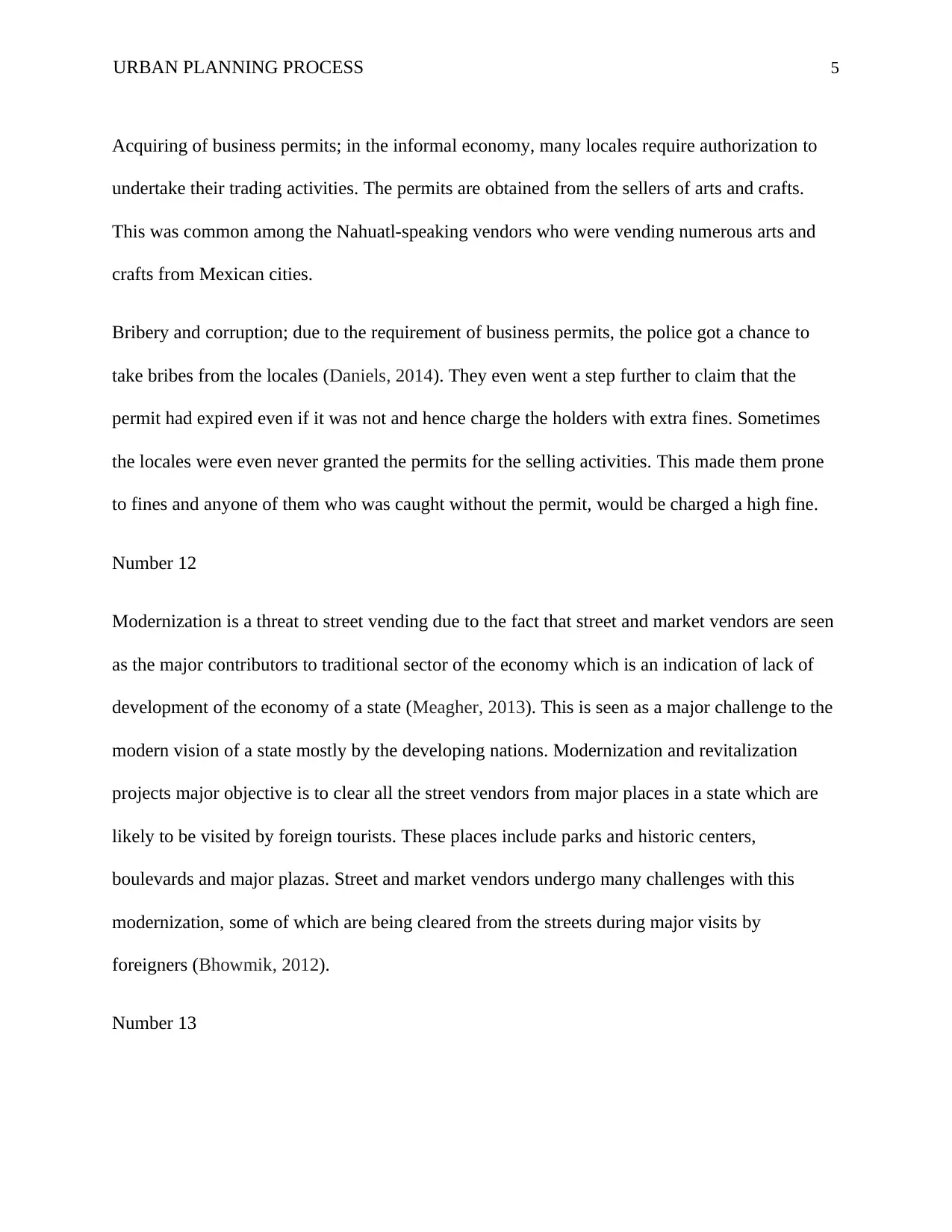
URBAN PLANNING PROCESS 5
Acquiring of business permits; in the informal economy, many locales require authorization to
undertake their trading activities. The permits are obtained from the sellers of arts and crafts.
This was common among the Nahuatl-speaking vendors who were vending numerous arts and
crafts from Mexican cities.
Bribery and corruption; due to the requirement of business permits, the police got a chance to
take bribes from the locales (Daniels, 2014). They even went a step further to claim that the
permit had expired even if it was not and hence charge the holders with extra fines. Sometimes
the locales were even never granted the permits for the selling activities. This made them prone
to fines and anyone of them who was caught without the permit, would be charged a high fine.
Number 12
Modernization is a threat to street vending due to the fact that street and market vendors are seen
as the major contributors to traditional sector of the economy which is an indication of lack of
development of the economy of a state (Meagher, 2013). This is seen as a major challenge to the
modern vision of a state mostly by the developing nations. Modernization and revitalization
projects major objective is to clear all the street vendors from major places in a state which are
likely to be visited by foreign tourists. These places include parks and historic centers,
boulevards and major plazas. Street and market vendors undergo many challenges with this
modernization, some of which are being cleared from the streets during major visits by
foreigners (Bhowmik, 2012).
Number 13
Acquiring of business permits; in the informal economy, many locales require authorization to
undertake their trading activities. The permits are obtained from the sellers of arts and crafts.
This was common among the Nahuatl-speaking vendors who were vending numerous arts and
crafts from Mexican cities.
Bribery and corruption; due to the requirement of business permits, the police got a chance to
take bribes from the locales (Daniels, 2014). They even went a step further to claim that the
permit had expired even if it was not and hence charge the holders with extra fines. Sometimes
the locales were even never granted the permits for the selling activities. This made them prone
to fines and anyone of them who was caught without the permit, would be charged a high fine.
Number 12
Modernization is a threat to street vending due to the fact that street and market vendors are seen
as the major contributors to traditional sector of the economy which is an indication of lack of
development of the economy of a state (Meagher, 2013). This is seen as a major challenge to the
modern vision of a state mostly by the developing nations. Modernization and revitalization
projects major objective is to clear all the street vendors from major places in a state which are
likely to be visited by foreign tourists. These places include parks and historic centers,
boulevards and major plazas. Street and market vendors undergo many challenges with this
modernization, some of which are being cleared from the streets during major visits by
foreigners (Bhowmik, 2012).
Number 13
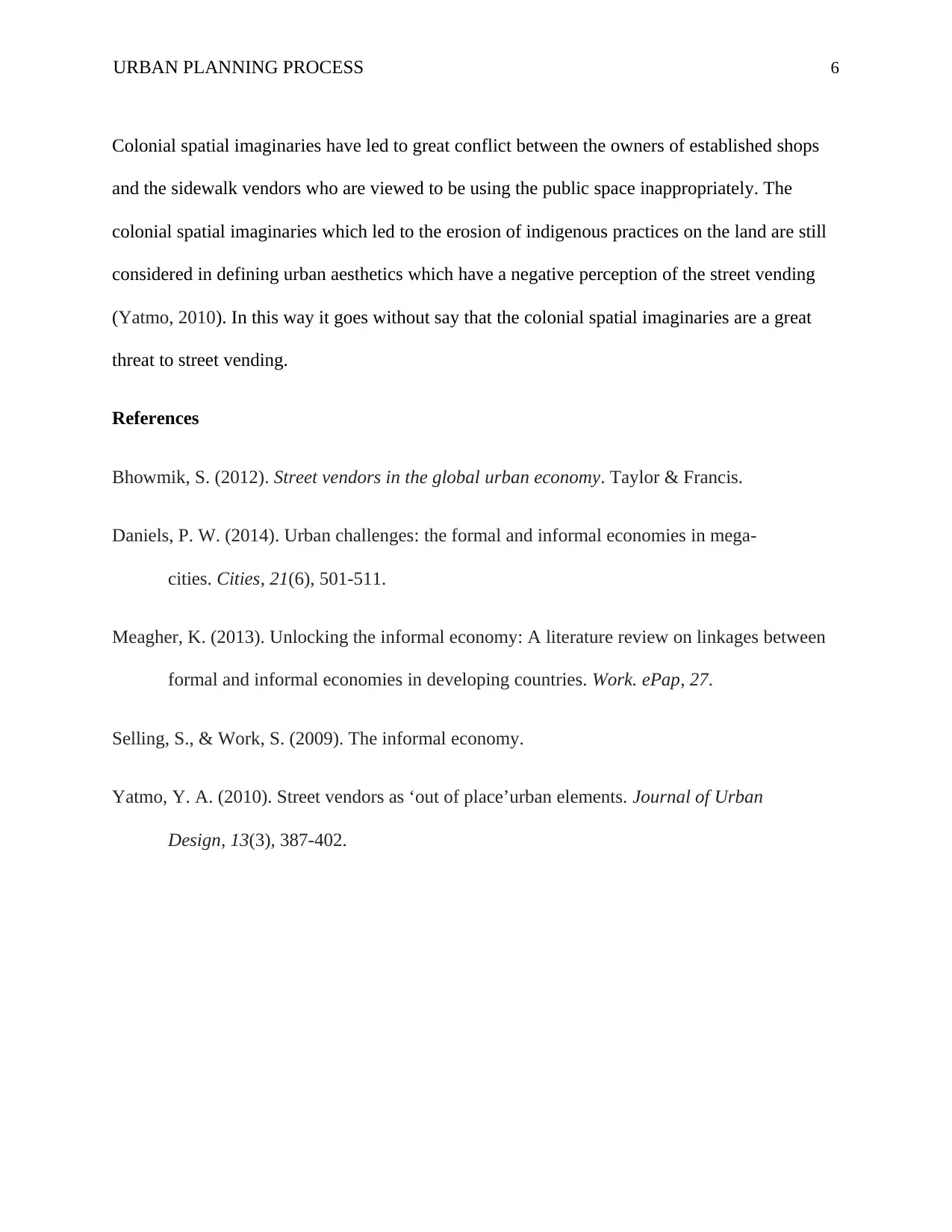
URBAN PLANNING PROCESS 6
Colonial spatial imaginaries have led to great conflict between the owners of established shops
and the sidewalk vendors who are viewed to be using the public space inappropriately. The
colonial spatial imaginaries which led to the erosion of indigenous practices on the land are still
considered in defining urban aesthetics which have a negative perception of the street vending
(Yatmo, 2010). In this way it goes without say that the colonial spatial imaginaries are a great
threat to street vending.
References
Bhowmik, S. (2012). Street vendors in the global urban economy. Taylor & Francis.
Daniels, P. W. (2014). Urban challenges: the formal and informal economies in mega-
cities. Cities, 21(6), 501-511.
Meagher, K. (2013). Unlocking the informal economy: A literature review on linkages between
formal and informal economies in developing countries. Work. ePap, 27.
Selling, S., & Work, S. (2009). The informal economy.
Yatmo, Y. A. (2010). Street vendors as ‘out of place’urban elements. Journal of Urban
Design, 13(3), 387-402.
Colonial spatial imaginaries have led to great conflict between the owners of established shops
and the sidewalk vendors who are viewed to be using the public space inappropriately. The
colonial spatial imaginaries which led to the erosion of indigenous practices on the land are still
considered in defining urban aesthetics which have a negative perception of the street vending
(Yatmo, 2010). In this way it goes without say that the colonial spatial imaginaries are a great
threat to street vending.
References
Bhowmik, S. (2012). Street vendors in the global urban economy. Taylor & Francis.
Daniels, P. W. (2014). Urban challenges: the formal and informal economies in mega-
cities. Cities, 21(6), 501-511.
Meagher, K. (2013). Unlocking the informal economy: A literature review on linkages between
formal and informal economies in developing countries. Work. ePap, 27.
Selling, S., & Work, S. (2009). The informal economy.
Yatmo, Y. A. (2010). Street vendors as ‘out of place’urban elements. Journal of Urban
Design, 13(3), 387-402.
⊘ This is a preview!⊘
Do you want full access?
Subscribe today to unlock all pages.

Trusted by 1+ million students worldwide
1 out of 6
Your All-in-One AI-Powered Toolkit for Academic Success.
+13062052269
info@desklib.com
Available 24*7 on WhatsApp / Email
![[object Object]](/_next/static/media/star-bottom.7253800d.svg)
Unlock your academic potential
Copyright © 2020–2025 A2Z Services. All Rights Reserved. Developed and managed by ZUCOL.